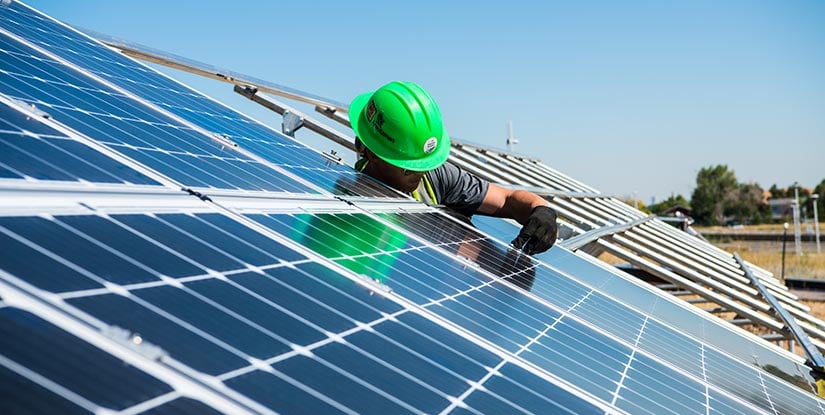Solar Futures Study
The Solar Futures Study explores pathways for solar energy to drive deep decarbonization of the U.S. electric grid and considers how further electrification could decarbonize the broader energy system.

The study was produced by the U.S. Department of Energy (DOE) Solar Energy Technologies Office and the National Renewable Energy Laboratory (NREL). It envisions how, over the next few decades, solar could come to power 40% or more of U.S. electricity demand, dramatically accelerating the decarbonization of buildings, transportation, and industry.
Key Findings
The study focuses on three future scenarios, two of which assume the U.S. electric grid becomes 95% decarbonized by 2035 and 100% decarbonized by 2050.
The scenario that results in the greatest reduction in carbon emissions assumes that an additional 30% of building energy loads, 14% of transportation energy loads, and 8% of industrial energy loads by 2050 will be electrified and added to the electric grid. Under this scenario, solar will grow from 3% of the U.S. electricity supply in 2020 to 40% by 2035 and 45% by 2050.
To achieve 95% grid decarbonization by 2035, the United States must install 30 gigawatts AC (GWAC) of solar photovoltaics (PV) each year between 2021 and 2025 and ramp up to 60 GWAC per year from 2025–2030. The United States installed about 15 GWAC of PV capacity in 2020.
With some technology advances, a 95% decarbonized grid can be achieved with no impact on 2035 electricity prices. The net incremental cost in 2050 of a 100% decarbonized grid, plus further electrification of buildings and transportation, will be about $210 billion, compared to a reference scenario. Avoided climate damages and improved air quality will result in net overall savings of $1.7 trillion.
Read more about the key findings of the report in an NREL fact sheet.
Publications
The Solar Futures Study is the most comprehensive review to date of the potential role of solar in decarbonizing the U.S. energy system. However, not all the analysis that informed the Solar Futures Study could be included within the main report. This further analysis is collected in additional NREL reports, each dedicated to a different technology area or socioeconomic topic.
The Solar Futures Study considers three future scenarios, two of which assume deep decarbonization of the electric grid and examines the role solar energy could play. The report contains the key findings from all the supporting reports, listed below. The Solar Futures Study was published in 2021 by the the DOE Solar Energy Technologies Office and was produced by NREL.
This 2021 report articulates PV technology research and development priorities that could enable the PV electricity cost targets within the Solar Futures Study scenarios. Specifically, the report considers a scenario in which PV reaches 1 terawatt of deployment in the United States by 2036 and up to 2 terawatts by 2050. It also examines the effects across the country if the cost targets are achieved.
Download The Role of Concentrating Solar-Thermal Power Technologies in a Decarbonized U.S. Grid .
This 2021 report examines the role of concentrating solar-thermal technologies in the Solar Futures Study’s scenarios with an emphasis on concentrating solar-thermal power (CSP), which refers to converting thermal energy to electricity. The report provides an overview of the CSP resource and market, presents results from the grid-scale capacity planning modeling, discusses likely research directions, and considers potential future markets beyond electricity generation.
This 2021 report examines the role building energy systems could play in the Solar Futures Study scenarios. Buildings use about 75% of electricity in the United States, so changes in building energy use have significant implications for grid operations. The report finds that demand-side grid resources in buildings are underutilized and present an opportunity to decarbonize grids more quickly and cost-effectively. It also considers some barriers to better use of these resources.
Download Maximizing Solar and Transportation Synergies.
This 2021 report considers the technological and market pathways that will enable better use of solar electricity as fuel for future transportation demand. For electric vehicles, technologies that enable wide-scale managed and coordinated charging are key in the near term and for future vehicle-to-grid functionality. For rail, air, and maritime transportation, the feasibility of increased PV use varies in the near term, but many options appear promising.
Download The Potential for Electrons-to-Molecules Using Solar Energy.
This 2021 report examines the role of electrons-to-molecules (E2M) technologies could play in the decarbonization envisioned in the Solar Futures Study. The report considers an array of potential products and system designs that can be tailored to different end-uses and applications. They all involve electrochemical conversion which uses electricity to break molecular bonds and produce new molecules. The report provides an initial overview of the potential opportunities and challenges for solar and E2M systems in this space and considers the potential for E2M to produce key chemicals and fuels that currently rely on hydrocarbons for production.
Solar energy technologies can be used as part of a suite of tools to reduce the energy burden of low- and moderate-income (LMI) electricity customers, but to date, these customers have not adopted solar at the same rate as other income groups. This 2021 report summarizes the barriers of and possible solutions to LMI solar adoption related to finance and funding, community engagement, site suitability, policy and regulatory, and resilience and recovery. In addition, the report models future LMI on-site solar adoption, using NREL's Distributed Generation Market Demand Model.
Download Environmental and Circular Economy Implications of Solar Energy in a Decarbonized U.S. Grid .
This report addresses environmental and circular economy considerations related to solar technologies via novel analysis of the three Solar Futures core scenarios as well as a synthesis of published research. The report organizes these issues into the three basic life cycle phases of a solar system: manufacturing, operation, and end of life. Related environmental justice issues are also explored. Finally, the report recommends research and development activities that could help clarify challenges and identify solutions.
Contact
Share
Last Updated Aug. 20, 2025
